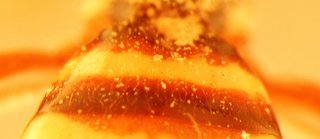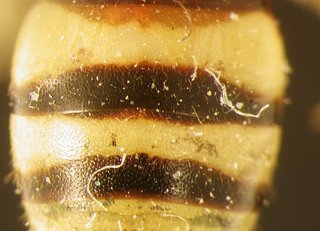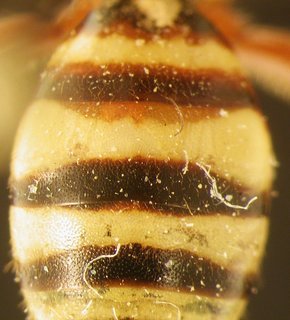|
80x5 -
240x3 -
240x4 -
320x1 -
320x2 -
320x3 -
640x1 -
640x2
Set display option above.
Click on
images to enlarge. |

© Copyright source/photographer
· 5
Nomada annulata, M, Back, OH, Washington County |

© Copyright source/photographer
· 5
Nomada annulata, M, Face, OH, Washington County |
|

© Copyright source/photographer
· 5
Nomada annulata, M, Side, OH, Washington County |

© Mary Paul
· 1
Nomada annulata T1 25% |
|

© Mary Paul
· 1
Nomada annulata T3 |

© Mary Paul
· 1
Nomada annulata T1-T3 |
|
Overview |
Reprinted with permission from: Mitchell, T.B. 1962 Bees of the Eastern United States. North Carolina Agricultural Experiment Station Technical Bulletin No. 152.
FEMALE—Length 8-9 mm.; lateral ocelli subequally distant from margin of vertex and each other; cheeks slightly narrower than eyes, posterior margin subcarinate above; shorter side of basal segment of flagellum fully equal to segment 2, median segments slightly longer than broad; mandibles unusually robust, quite strongly flattened, outer margins strongly bowed, almost angular, inner margin relatively straight; wings subhyaline basally, becoming lightly infuscated apically, with the usual three submarginal cells, 2nd quite broad anteriorly, 3rd very strongly narrowed, veins testaceous, basal vein slightly basad of transverse median, almost interstitial; tegulae shining between deep, distinct, rather coarse punctures which are close anteriorly, slightly more sparse posteriorly; posterior margin of scutellum only very faintly impressed medially, if at all; front coxae not spinose; apex of hind tibiae with a pair of short but robust, reddish bristles; clypeus, supraclypeal area,
lateral facial maculae extending completely around eyes, and a small spot below anterior ocellus, bright yellow; labrum somewhat more yellowish-testaceous, mandibles and antennal scape testaceous, flagellum more brownish-testaceous; pronotal collar, tubercles, tegulae, scutellum, adjacent median area of metanotum narrowly, lateral margins of scutum and adjacent axillae, and usually a pair of narrow, submedian lines, an anterior and a dorsal maculation on mesopleura, and a pair of broad maculations on propodeum, bright yellow; mesopleura above largely ferruginous posterior to and beneath the yellow maculae; coxae with small yellow maculae, but otherwise testaceous, trochanters and femora testaceous in large part, tibiae largely yellow, hind pair somewhat testaceous apically; front and middle basitarsi yellowish, the more apical tarsal segments and hind tarsi entirely, more testaceous, spurs pale yellowish; abdominal terga 1-5 with entire, broad, transverse, yellow bands, that on tergum 1 submedian and rather narrow, those on 2 and 3 sub-basal, sometimes interrupted medially by a broad ferruginous area on 2, those on 4 and 5 subapical; impressed apical margins more ferruginous on 4 and 5, piceous on 1-3, and base of 1 piceous; sterna 2-5 with more or less extensive, transverse, basal, yellow areas, apical margins rather broadly and obscurely brownish-hyaline; punctures close, deep and distinct over most of head, coarsely so above antennae and at sides of face below, more finely so on cheeks and vertex, the supraclypeal area and clypeus laterally with coarse and deep punctures, these becoming very fine and rather obscure on clypeus medially; scutum quite coarsely and densely rugoso-punctate, scutellum with rather sparse, coarse and deep punctures, pleura very coarsely, deeply and quite closely punctate below, but with some shining interspaces evident, becoming densely crowded above; propodeum rather finely rugoso-punctate, triangle irregularly striate, rather coarsely so along upper margin; discs of abdominal terga with rather deep, distinct, fine and slightly separated punctures, apical rims becoming narrowly impunctate, punctures extremely minute on tergum 1 but still quite close basally, those on 4 and 5 relatively coarse and well separated toward the apical impressed margins which are more or less reddish; pseudopygidium transverse, median length almost half the breadth, forming the apical margin of tergum 5, densely covered with suberect, silvery tomentum; pubescence extremely short and thin but rather copious over head and thorax, yellowish above, somewhat more whitish below, barely evident on abdomen dorsally, more elongate and very thin on sternal plates, sternum 5 with apical
tufts of elongate, yellowish hairs on each side of mid-line, these converging medially.
MALE—Length 6.5-9.5 mm.; lateral ocelli slightly nearer margin of vertex than to each other; cheeks more than half width of eyes, posterior margin carinate above; antennal scape strongly swollen, apex rather deeply excavated, partially enclosing pedicel, shorter side of basal segment of flagellum fully equal to segment 2, median segments very slightly longer than broad; mandibles robust, somewhat flattened, outer margins slightly angulate, inner margin nearly straight; wings hyaline basally, becoming lightly infuscated apically, with the usual three submarginal cells, 2nd somewhat broader anteriorly than 3rd, veins yellowish, basal vein very slightly basad of transverse median; tegulae shining between fine but quite deep and distinct, rather close punctures, these becoming more sparse posteriorly; posterior margin of scutellum very slightly grooved medially; front coxae not spinose; hind femora slender and simple; face below antennae yellow except for some blackened areas just below each antennal fossa, the lateral facial maculae extending very narrowly to top of eye; cheeks below narrowly yellow along eye margin; antennal scape yellow anteriorly, black posteriorly, flagellum brownish-testaceous; pronotal collar in part, tubercles, tegulae, transverse maculations on scutellum, and a rather small anterior maculation on mesopleura, bright yellow, thorax otherwise black; legs chiefly bright yellow, but femora more or less testaceous to piceous on posterior face, and hind coxae black; spurs pale yellow; abdominal terga 1-6 with entire, transverse, yellow bands, that on 1 submedian and rather narrow, that on 2 sub-basal, very broad laterally, slightly narrowed medially, those on 3 and 4 sub-basal, more nearly apical on 5 and 6, apical margins more or less yellowish-hyaline on the more apical terga; abdominal sterna 2-6 largely bright yellow, apical margins broadly yellowish-hyaline; punctures very coarse, deep and close on face above antennae, becoming somewhat finer but still very close on vertex laterally and on cheeks, much finer and very close below antennae, very fine and distinct on clypeus; entire thorax densely rugoso-punctate, the pleura very coarsely so below, punctures of scutellum somewhat more distinct, propodeal triangle impunctate but rather finely and irregularly substriate; abdominal terga very finely and rather closely punctate, tergum 1 very minutely so, becoming impunctate toward base; punctures of the more apical terga becoming somewhat more coarse and distinctly separated, apical rims very narrowly impunctate; pubescence pale yellowish, short and thin but rather copious over head and thorax, hardly evident on abdomen dorsally, more elongate but very thin and sparse on abdominal sterna; sternum 6 quite densely fringed on each side with elongate yellowish hairs, the apical pubescence erect and quite dense; basal width of pygidial plate about equal to median length, quite strongly narrowed apically to the narrowly but deeply incised tip, margins carinate, surface very finely and closely punctate; sternum 6 triangular; sternum 8 and gonocoxites
genital armature as shown (figs. 103 & 104).
DISTRIBUTION—North Carolina, April and May.
FLOWER RECORDS—Claytonia, Rubus and Senecio.
HOST—Andrena macra Mitchell.
|
|
|
Names | |
|
|
| Supported by | |
Updated: 2024-04-25 14:07:07 gmt
|